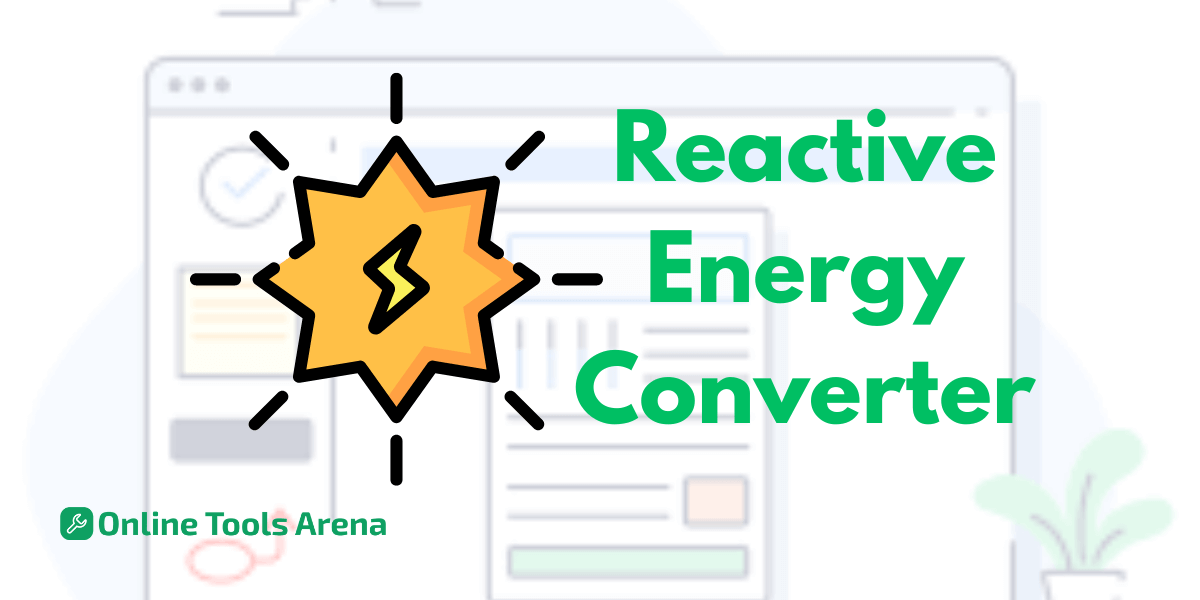
Reactive Energy Converter
Enhancing Grid Stability and Efficiency
Our Reactive Energy Converter
OnlineToolsArena is a hub for free online converters and tools. Our platform provides a smooth and uninterrupted experience. We assure you that you can quickly and efficiently convert your documents, images, and more. No downloads, no hidden fees—just reliable, fast, and secure conversions at your fingertips. Simplify your digital tasks with our easily operated reactive energy converter. Our reactive energy converter is an online tool that operates in a very user-friendly manner. Use this reactive energy converter to improve power quality, reduce waste, and boost energy efficiency. Every converter in OnlineToolsArena is designed to handle every task accurately and perfectly. Using our converter, you will not waste time downloading any software or dealing with any signup hassle. So feel free to convert and customize your file, documents, images, and more. Fast and secure.
Basics of Voltage and Reactive Power
However, before you use a Reactive Energy Converter, you should have at least some understanding of basic electrical concepts. Voltage is measured in volts (V) and represents the electric potential difference between any two points along a circuit. VARs represent that portion of power which swings back and forth between source and load without performing useful work.
Voltage
Definition: Voltage, or electric potential difference, is the motive force behind an electrical current. It is expressed in volts (V).
Symbol: V stands for voltage.
Types of Voltage
Direct Current (DC) Voltage: The voltage is time-independent.
Alternating Current (AC) Voltage: The voltage alternates direction periodically. Power distribution typically uses AC voltage.
Voltage in AC Systems: AC voltage is usually expressed in terms of amplitude (peak voltage), frequency, and phase.
Voltage Sources: Voltage can be provided by generators, batteries or power supplies.
Reactive Power
Definition: In an AC circuit, reactive power is the energy exchanged between electric and magnetic fields. It is expressed in volt-amperes reactive (VAR).
Symbol: Q is often used as a symbol to represent reactive power.
Types of Power
Real Power (P): The true power which does the work is measured in watts (W).
Reactive Power (Q): This power does no work but is required to maintain voltage levels and allow the actual flow of real power.
Power Triangle: Power (P), reactive power (Q) and apparent power (S) form a triangle. The apparent power is the vector sum of real and reactive powers.
Power Factor: Power factor (PF) is the ratio of real power to apparent power. Ranging from 0 to 1, with a value of 1, meaning that all power is real,.
Capacitive and Inductive Loads: leading reactive power is generated by capacitive loads (capacitors, etc.) In particular, inductive loads (such as motors and transformers) produce lagging reactive power.
Volts to VARs
The voltage V and the power factor of the electrical system are needed to convert volts into VARs. The formula for this conversion is VARs = V I (1 - PF), with the current in amperes. The Reactive Energy Converter simplifies such calculations. Input values and get a result immediately.

How To Use Our Reactive Energy Converter
Input Data: In the input box, enter the value of reactive energy you want to convert.
Select Units: Select the current unit of your input value and desired output unit from drop-down menus.
Hit Convert: Press the 'Convert' button, and it will process this result for you.
FAQs
What is Reactive Energy? Reactive energy, measured in volt-amperes reactive (VAR), represents the energy that oscillates between the source and load in an AC circuit. It does not perform any real work but is essential for maintaining voltage levels within the power system
How does the reactive energy converter work?
The Reactive Energy Converter tool simplifies the process of converting reactive energy from one unit to another. You input the value and select the units you want to convert from and to, and the tool will instantly provide the conversion result.
What units can be converted using the reactive energy converter?
Our tool can convert between several units, including:
- Volt-amperes reactive-hour (VARh)
- Millivolt-amperes reactive-hour (mVARh)
- Kilovolt-amperes reactive-hour (kVARh)
- Megavolt-amperes reactive-hour (MVARh)
- Gigavolt-amperes reactive-hour (GVARh)
What is the importance of converting volts to VARs?
Converting volts to VARs is important for accurate power management in AC circuits. It helps in designing efficient electrical systems, managing power distribution, and ensuring the stability of power grids.











